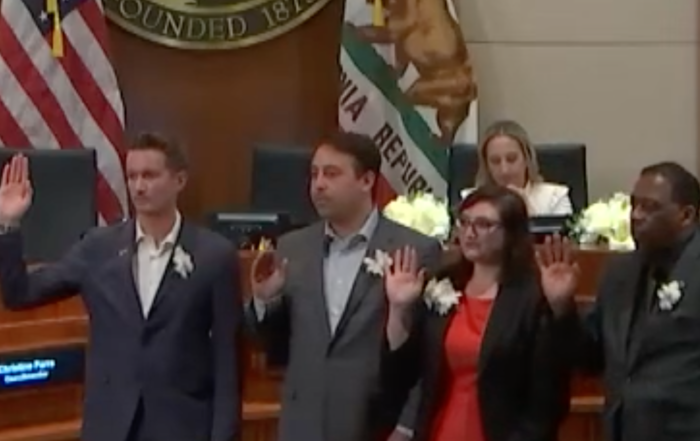After the fall of the Soviet Union, and in the face of anti-Semitic oppression, Natalya Zernitskaya’s family fled from Belarus in 1995. She was six years old when they arrived in San Francisco, welcomed by relatives who shared a rent-controlled apartment with her family. Her first bed was a discarded cot, and her first trip to the grocery store reminded her of a board game.
“We were really lucky that we landed in a place where folks had the foresight to develop vital safety nets,” she said. “We were able to get our own apartment in San Francisco that was rent controlled. So even though my parents had lower wage jobs, and we had to be on government assistance, like food stamps—this was back in the day when they looked like Monopoly money—I was able to get a really great public school education in San Francisco … and eventually, my parents were able to get better jobs and to save up enough money to achieve the American dream of buying their own home.”
Despite her memory of the food stamps, Zernitskaya’s life in America did not resemble a Monopoly game, as it was never overshadowed by the ruthless competitiveness of landlords. After majoring in Economics at UC Santa Cruz, she moved to Santa Monica 10 years ago, where she witnessed the benefits of rent control once again, renewing her appreciation for the long-term stability that it provides for residents.
She was shocked in 2022 when Santa Monica City Councilmember Lana Negrete— supported by Mayor Phil Brock, Oscar de la Torre, and Christine Parra—proposed a substantial revision to the city’s then 43-year-old rent control ordinance.
Negrete’s “Tenant Income Inequality Relief Plan” sought to impose the Rent Board’s mandated six percent increase on a unit’s Maximum Allowable Rent (MAR), meaning that only tenants paying above the MAR would pay the six percent increase.
“The proposal was trying to assume people’s ability to pay or how rent-burdened they were based on just how much they’re paying for rent, which doesn’t make sense,” Zernitskaya said. “It’s not a direct correlation. And it would have violated one of the core requirements of rent control for it to be constitutional because you have to be able to provide a fair return for the owners, so if you have it at zero percent for some and up to six percent for others, then … that could have potentially opened up our entire rent control charter amendment to challenge.”
Expanding upon her support for rent control, she points to existing resources like the Community Corporation of Santa Monica, the largest non-profit provider of affordable housing in the city, as an exemplary model that upholds dignity and privacy for its residents.
“With affordable housing, some people might have a negative perspective in their minds, but Santa Monica actually has quite a bit of deed-restricted affordable housing, and you would not know that that’s what it was unless somebody told you,” she said. “For example, one of my friends unfortunately passed away back in March, and I didn’t know until after that, when her sister came to help clean out her apartment, that the building she was living in was a Community Corp building. I had literally no idea because it just looks like any normal apartment building on the block. So affordable housing is all around us, and affordable housing is nothing to be afraid of.”
As she explores ways to alleviate homelessness, she highlights another Santa Monica program that she admires and would like to expand: Preserving our Diversity (POD), a program that provides cash assistance to seniors who are at lower income levels and who have lived in their apartments for a certain period of time.
“That couple hundred bucks a month, for some folks, doesn’t sound like a lot, but for the people this is helping, it’s the difference between having to choose between getting your medication and paying rent, having to choose between getting groceries and paying rent,” she said. “So it really provides this vital lifeline, and it gives people just a better quality of life. For only a few $100 a month, I feel like that’s a really good deal … and it helps keep folks from falling into homelessness, which is an incredibly destabilizing experience for them and for their families.”
As a Senior Due Diligence Analyst for a financial firm, she also loves policy analysis—gladly accepting the label “policy wonk”—and looks forward to navigating the interconnectedness of Santa Monica’s city budget. Noting that seventy percent of the general fund budget comes from local sources, she reminds residents that Santa Monica can better provide services, programming, and resources when the city’s economy is doing well. She is particularly interested in exploring ways to increase the hours and staffing at the public library.
On the other hand, she is unclear why the current city council is calling for four more police officers in the budget when sixteen open positions remain unfilled, and she would like to see the city do a better job of communicating with the community.
“We’re still having trouble recruiting, and I don’t exactly know why, but we also need to look at other ways to help people feel safe. Is it encouraging folks to start Neighborhood Watch programs so that everyone’s in it together and they can have these ongoing conversations with our first responders and our public safety officers? Is it fixing up street lights? … But folks need help, not just punishment. A jail cell is not a rehabilitation space.”
She has faith in Santa Monica’s capacity to solve complex problems, and her voice overflows with enthusiasm when discussing innovative approaches such as the city’s pilot program for a Zero Emission Delivery Zone in 2022, which provided priority parking for electric delivery vehicles in the downtown area.
She and her dog Sadie, whom she fostered and adopted through a local rescue program, can often be seen enjoying Santa Monica’s fresh air and local parks. In her spare time, she enjoys crafting, painting, knitting, and making origami, though she also notes that she is proud of her impressive collection of over 300 rubber ducks.
“My collection started unintentionally many years ago with some rubber ducks I won at an arcade, then some friends noticed them and started getting me new and unique ones as gifts,” she said. “I enjoy collecting them because I like pun-based humor, and I can joke that I have my ducks in a row, but also because they just make people smile.”
Photo courtesy of the candidate.
Stay informed. Sign up for The Westside Voice Newsletter
By clicking submit, you agree to share your email address with Westside Voice. We do not sell or share your information with anyone.








